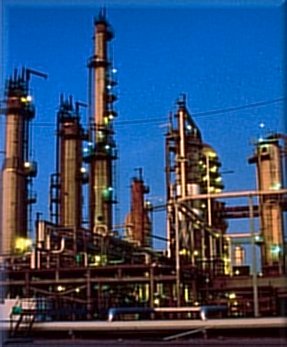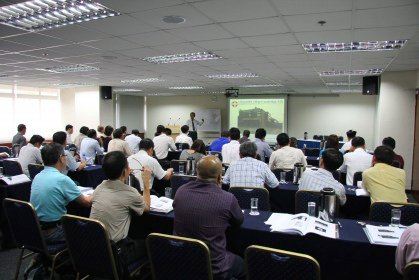|
Home | Consulting | Training | Expert Witness | Failure Analysis | Design Review | Corrosion Test | Corrosion Software | Protective Coatings | Materials Selection | Cathodic Protection | >>> | ||
|
Corrosion in Oil Refineries: Inspection, Monitoring and Control |
||
|
Course Outline | Who Should Attend | Registration | In-House | On-Demand | Online Courses | PPT Slides+Testbank | Course List | Why WebCorr |
||
| Course Overview | ||
|
This 5-day corrosion short course covers corrosion inspection, corrosion monitoring and corrosion control in oil refineries.
This corrosion short course is available for on-site training, online and distance learning worldwide. It can also be customized to meet the specific needs of your organization.
|
||
|
||
| Course Outline | ||
|
1. Review of Corrosion Basics
1.1 Introduction to
Corrosion
2. Overview of Refinery Operations
3. Refinery Corrosion and Inspection
3.1 Low-Temperature
Refinery Corrosion
3.8 Damage Mechanisms in Specific
Units
4. Refinery Inspection Areas of Vulnerability 4.1 Special Inspection Considerations 4.1.1 General 4.1.2 Piping 4.1.3 Safety Relief 4.1.4 Heaters 4.1.5 Exchangers 4.1.6 Vessels 4.1.7 Tanks 4.2 Specific Problem Events 4.2.1 Crude 4.2.2 Vacuum 4.2.3 Coker 4.2.4 Cracker 4.2.5 Gas Plant 4.2.6 Reformer 4.2.7 HDS 4.2.8 Alkylation 4.2.9 Hydrocracker 4.2.10 H2 Reformer 4.2.11 Ethylene 4.2.12 Benzene 4.2.13 Sulphur Recovery 4.2.14 Boiler 4.2.15 Pressure Storage 4.2.16 Piping 4.2.17 Atmospheric Storage 4.3 Process Industry Equipment Life 4.4 Potential Increased Refinery Corrosion Guideline 4.5 Guidelines for Reporting Refinery Unit Process Changes That Can Potentially Increase Corrosion Rates
5. Corrosion Monitoring Methods in Refineries
5.1 The Need for
Corrosion Monitoring
6. Corrosion Control in Refineries
6.1 Corrosion Mitigation Methods
6.3.9 Corrosion Modeling and Corrosion Prediction with CRA-Compass 6.1 Introduction to Failure Analysis in Refineries 6.2 Procedural Approach and Test Methods 6.3 Guidelines to Failure Analysis in Refineries
6.7
Software Solutions for Refinery Corrosion: Corrosion Prediction Software
for the Refining and Petrochemical Industries
|
||
|
Course Outline |Who Should Attend |Registration |In-House |On-Demand |Online Courses |PPT Slides+Testbank |Course List |
||
| Who Should Attend This Corrosion Course | ||
|
Designers, Inspection Engineers, Maintenance Engineers, Plant Inspectors, Mechanical Engineers, and Process Engineers in the refining and petrochemical industries.
|
||
| Registration for This Corrosion Course | ||
|
Click here to register for this corrosion course online, or Click here to download this corrosion course brochure with registration form in PDF format.
|
||
| In-House Training Corrosion Courses | ||
|
There is no limit to the number of participants required for in-house training corrosion courses. We conduct the in-house training corrosion course at your company's premises worldwide, and at a time convenient to your company.
Click here to contact us for a quotation for in-house training corrosion courses. |
||
| Corrosion Course-On-Demand | ||
|
Click here to contact us for a quotation. |
||
| Online and Distance Learning Corrosion Courses | ||
|
Click here to to register an online corrosion short course. |
||
| PowerPoint Slides and Test Banks for Trainers, Instructors, Tutors, University Lecturers and Professors | ||
|
If you are involved in teaching or training, you may wish to purchase a complete set of the trainer's package for this training course. The trainer's package comes complete with ready-to-use PowerPoint slides (fully editable) and test bank (with answer keys). These ready-to-use PowerPoint slides contain high quality color photographs, illustrations, animations, audio and video clips. The test bank contains questions conveniently grouped into four categories: (1) true or false, (2) multiple choice, (3) calculation, and (4) reasoning and open-ended discussions. The trainer's package is suitable for in-house training and university teaching (30 lecture hours). This is exactly the same package that WebCorr uses to deliver our current training course. The one-time lump sum fee allows your organization to use the training package and also modify it. For example, your organization may modify the course contents and re-name/re-brand the course under your organization’s name. WebCorr only retains the copyright of the original PowerPoint slides and test banks.
Click here to contact us if you need more information on the trainer's package. |
||
|
Course Outline |Who Should Attend |Registration |In-House |On-Demand |Online Courses |PPT Slides+Testbank |Course List |
||
|
Copyright © 1995-2024. All rights reserved. |
||
 Statistics
shows that the total cost of corrosion control in refineries in the US
alone is estimated at $3.692 billion. Of this total, maintenance-related
expenses are estimated at $1.767 billion annually, vessel turnaround
expenses account for $1.425 billion annually, and fouling costs are
approximately $0.500 billion annually. Significant cost reduction can be
achieved with timely and appropriate corrosion inspection. Asset
integrity can be enhanced with corrosion monitoring and corrosion
mitigation methods such as materials selection and chemical treatment.
Statistics
shows that the total cost of corrosion control in refineries in the US
alone is estimated at $3.692 billion. Of this total, maintenance-related
expenses are estimated at $1.767 billion annually, vessel turnaround
expenses account for $1.425 billion annually, and fouling costs are
approximately $0.500 billion annually. Significant cost reduction can be
achieved with timely and appropriate corrosion inspection. Asset
integrity can be enhanced with corrosion monitoring and corrosion
mitigation methods such as materials selection and chemical treatment.  If you are concerned with corrosion in your
company, in-house training or on-site training is a great solution to train a group of
employees from design, production, operation, quality assurance, inspection
and maintenance, and technical sales and support on corrosion control and
corrosion prevention technology. The contents of all our corrosion courses can
be customized to fit your organization's needs.
If you are concerned with corrosion in your
company, in-house training or on-site training is a great solution to train a group of
employees from design, production, operation, quality assurance, inspection
and maintenance, and technical sales and support on corrosion control and
corrosion prevention technology. The contents of all our corrosion courses can
be customized to fit your organization's needs.
 All our publicly scheduled corrosion short courses are conducted once a year. However, you do not need to wait for one year if you have missed any of the publicly scheduled corrosion courses as we have this unique corrosion course-on-demand scheme: we will conduct the course just for you
(on an one-on-one basis) or for a small group from your company at a time and in a location convenient to you. This option costs significantly less than a full-scale in-house
or on-site corrosion training program.
All our publicly scheduled corrosion short courses are conducted once a year. However, you do not need to wait for one year if you have missed any of the publicly scheduled corrosion courses as we have this unique corrosion course-on-demand scheme: we will conduct the course just for you
(on an one-on-one basis) or for a small group from your company at a time and in a location convenient to you. This option costs significantly less than a full-scale in-house
or on-site corrosion training program. All
our corrosion short courses are available for online or offline distance
learning. You can start an online corrosion course at any time and learn
at your own comfortable pace and schedule, whenever and wherever you
are. You have around-the-clock access to the interactive and media-rich
course materials, virtual labs, course instructions and course assessments. Discussions and questions related to the corrosion courses
are posted on the website or exchanged through email for a period up to 3 months. Video conferencing or instant messaging can also be arranged for discussions of course topics.
For those who do not have ready access to internet, we can send
you our online course materials on a CD-ROM, or DVD, or USB flash drive for offline
distance learning.
All
our corrosion short courses are available for online or offline distance
learning. You can start an online corrosion course at any time and learn
at your own comfortable pace and schedule, whenever and wherever you
are. You have around-the-clock access to the interactive and media-rich
course materials, virtual labs, course instructions and course assessments. Discussions and questions related to the corrosion courses
are posted on the website or exchanged through email for a period up to 3 months. Video conferencing or instant messaging can also be arranged for discussions of course topics.
For those who do not have ready access to internet, we can send
you our online course materials on a CD-ROM, or DVD, or USB flash drive for offline
distance learning.